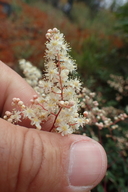Taxon Report
Holodiscus discolor (Pursh) Maxim. var. cedrorum (Raiche & Reveal) D. Potter & RaicheCedars oceanspray |
 © 2024 Aaron Arthur |
Taxon Summary
Holodiscus discolor var. cedrorum, commonly known as Cedars oceanspray, is a perennial deciduous shrub in the Rosaceae that is found only in California. It occurs within Chaparral (sometimes), and Closed-cone coniferous forest, growing at elevations from 170 to 540 meters. Holodiscus discolor var. cedrorum is ranked 1B.3, Plants Rare, Threatened or Endangered in California and Elsewhere; Not very threatened in California.Classification
|
Scientific Name: |
Holodiscus discolor (Pursh) Maxim. var. cedrorum (Raiche & Reveal) D. Potter & Raiche |
|
Common Name: |
Cedars oceanspray |
| Family: | Rosaceae |
| Element Code: | PDROS0V041 |
| USDA Plants Symbol: | |
|
Synonyms/Other Names: |
|
Ecology and Life History
| Lifeform: | perennial deciduous shrub |
| Blooming Period: (Apr)May-Jun(Jul) | (Apr)May-Jun(Jul) |
| Elevation: | 170-540 (560-1770) |
| General Habitats: | Chaparral, Closed-cone coniferous forest |
| Microhabitat: | Serpentine |
| Microhabitat Details: | Usually on peridotite. Locally common on lower canyon slopes in relatively mesic, old-growth Hesperocyparis sargentii woodland where it may be encountered even in dense shade. Sometimes found in chaparral, predominantly on north-facing slopes. |
Conservation Status
| CA Rare Plant Rank: | 1B.3 |
| Global Rank: | G5T1 |
|
State Rank: |
S1 |
| State List: | None |
| Fed List: | None |
| Other Status: | BLM_S |
|
CRPR Changes: |
|
Occurrence Data from the CNDDB
| Total Occurrences: | 9 |
| Element Occurrence Ranks: | |
| Excellent (A) | 0 |
| Good (B) | 0 |
| Fair (C) | 0 |
| Poor (D) | 0 |
| None (X) | 0 |
| Unknown (U) | 9 |
| California Endemic: False | |
| California Counties and Islands: Name (Code) | |
| Sonoma (SON) | |
| Quads: Name (Quad Code) | |
| Cazadero (3812351), Fort Ross (3812352), Tombs Creek (3812362) | |
Threat List Data from the CNDDB
| Threat List Total: | 0 | |
| EOs with Threat Listed: | Total EOs | % of EOs |
| 0 | % | |
|
|
||
Selected References
| Proposed addition to CRPR 1B.3, G1T1 / S1 (2024) |
| Journal of the Botanical Research Institute of Texas 5(1): 25–32 (2011) |
| Phytotaxa 477(2): 284–290 (2020) |
Citation
California Native Plant Society, Rare Plant Program. 2025. Rare Plant Inventory (online edition, v9.5.1). Website https://www.rareplants.cnps.org [accessed 27 December 2025].